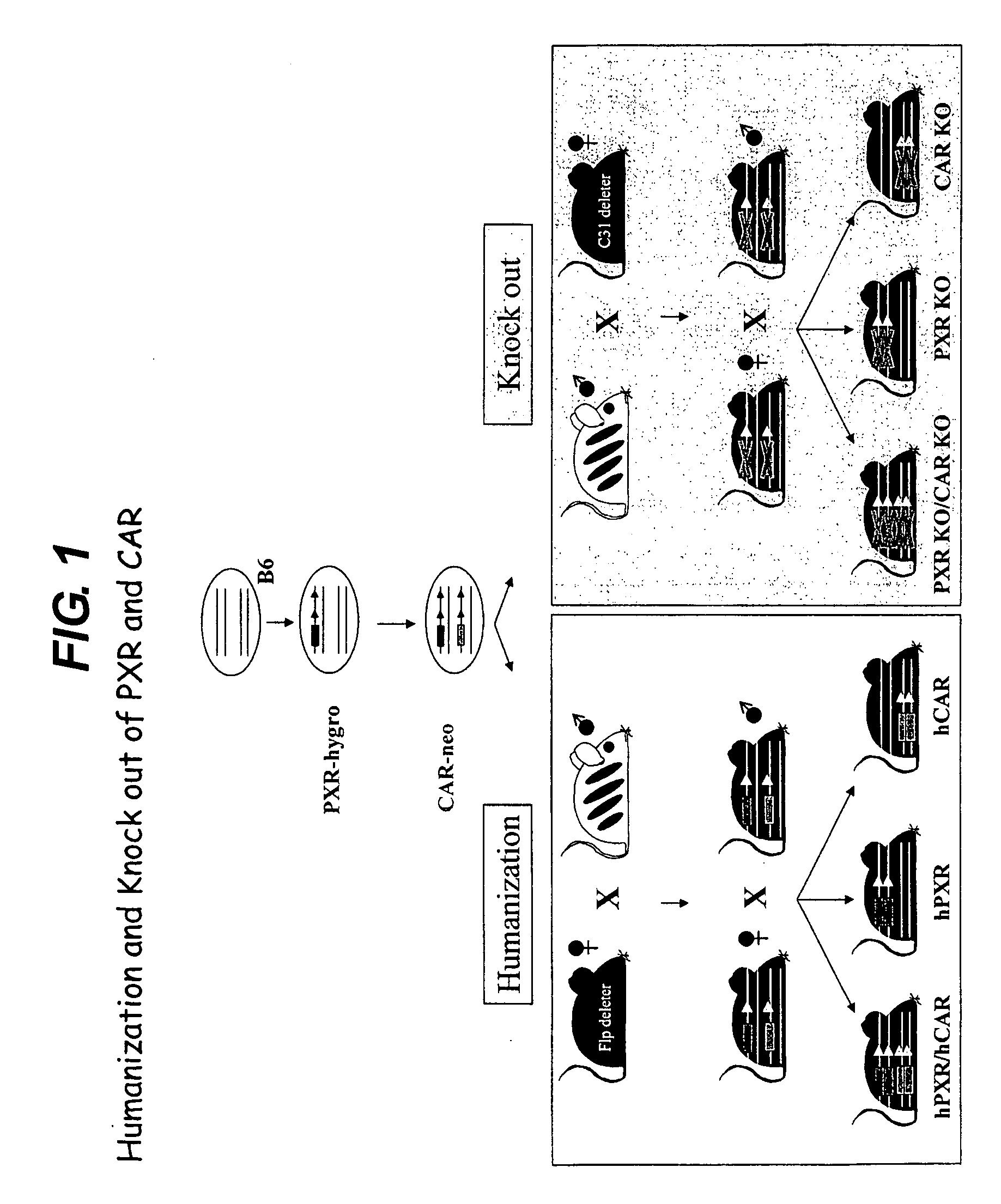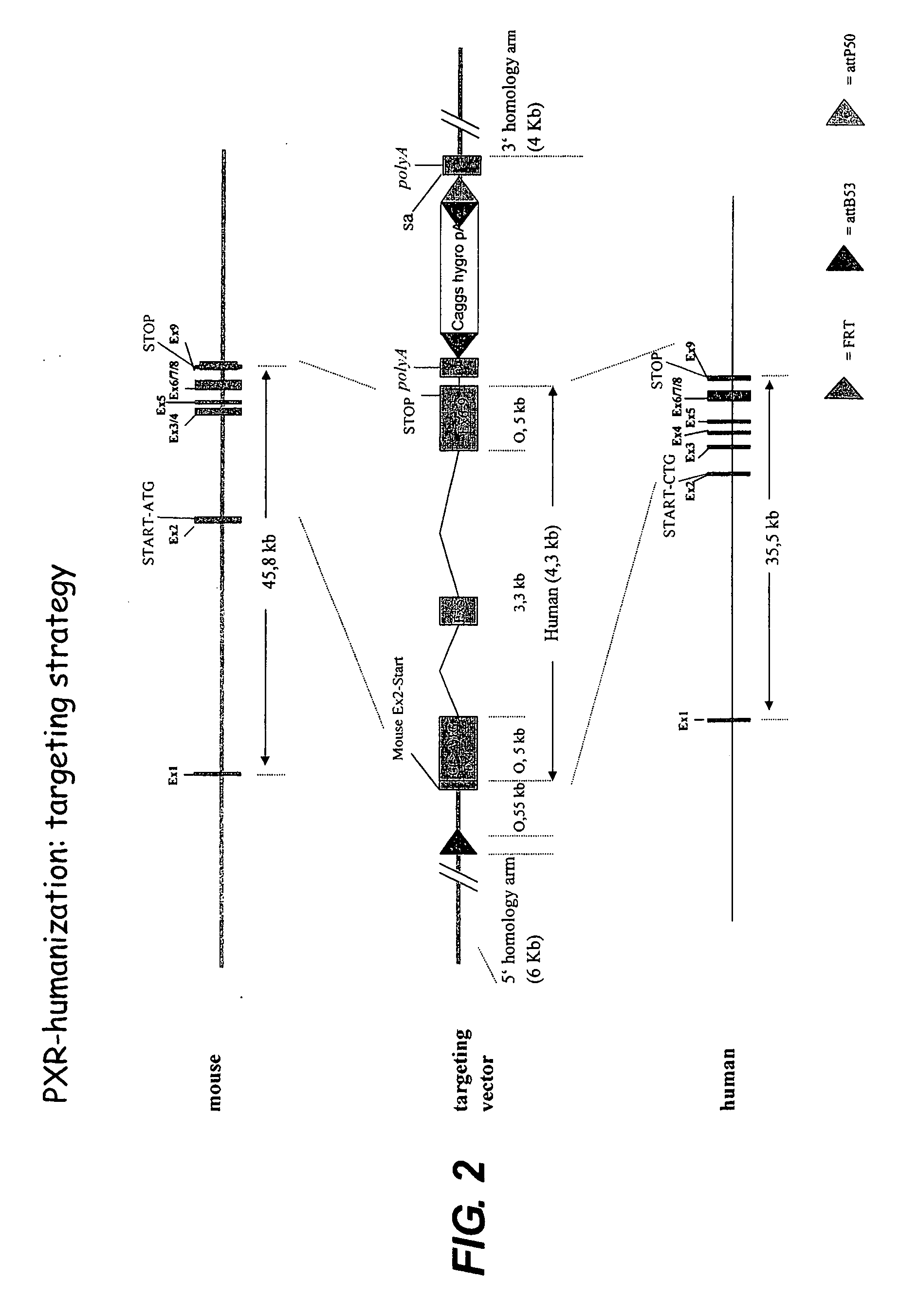Transgenic animals for assessing drug metabolism and toxicity
a technology of metabolism and toxicity, which is applied in the field of transgenic nonhuman animals, can solve the problems of significant waste of development expenditure, no method is completely reliable in predicting metabolism or toxicity in a human subject, and a significant proportion of drug candidates fail to become marketable drugs, so as to reduce the extent of attrition in drug discovery, save test animals' lives, and reduce the number of animals
- Summary
- Abstract
- Description
- Claims
- Application Information
AI Technical Summary
Benefits of technology
Problems solved by technology
Method used
Image
Examples
example 1
The Humanised PXR / CAR Mouse
[0374]The method provides for the humanisation of mice for PXR and CAR alone or as a double humanised form for each of the genes (see FIG. 1). We have combined these different humanisations by a step-wise transformation of embryo stem cells (ES cells) rather than by conventional breeding and thus are able to generate PXR / CAR double humanised ES cells, which are usable for subsequent modifications with human DNA sequence encoding a phase-1 or 2 drug-metabolising enzyme human DNA sequences encoding a drug transporter protein.
[0375]The application of PhiC31 recombination sites enabled us to knock out both genes by crossing the humanised animal to a Phi31 deleter strain.
[0376]In contrast to existing models, we utilise a “knock-in” approach to replace the endogenous genes by their human orthologues (FIGS. 2 and 3). Therefore the PXR and CAR genes will be kept under their normal genomic context and expression levels and transcript distribution is advantageously ...
example 2
The HRN™ Mouse
[0379]All P450s require reducing electrons supplied by the enzyme cytochrome P450 reductase (CPR). Deletion of CPR therefore simultaneously inactivates all P450s. While CPR deletion is lethal in the embryo, HRN™ mice use a developmentally regulated conditional CPR deletion targeted to post-natal liver cells. HRN™ mice therefore survive to adulthood and can breed while nevertheless completely lacking hepatic P450-mediated metabolism (Henderson C J et al. J Biol. Chem. 278:13480-6, 2003). They therefore provide a suitable background on which to express human P450 activities in order to achieve P450 humanisation.
Transgenic Mouse Production
[0380]An adenoviral vector may be used to introduce the human P450 / CPR combination to HRN™ cells. Alternatively, germ line transgenic animals incorporating the same transgenes can be produced. This is achieved by first generating transgenic mice incorporating the selected CYP3A4 / CPR humanisation transgenes and then crossbreeding these wi...
example 3
Humanization Projects
[0382]Type 1: Expression of Human cDNA from the Corresponding Mouse Promoter
Projects: MDR1-Humanization
[0383]Methods: The targeting vectors are constructed with standard molecular cloning procedures. These vectors are designed in such a way, that the cDNA of human MDR1 is fused to the translational start site of the corresponding mouse genes (Mdr1a and Mdr1b). The Mdr1a targeting vector carries an FRT-flanked hygromycin resistance cassette, the Mdr1b targeting vector an F3-flanked neomycin resistance cassette. In both cases the transcripts are terminated by a polyA motif. In case of Mdr1a the targeting event removes the 3′part of exon2, in case of Mdr1b the 3′part of exon2 to exon4 are deleted. See FIGS. 4 and 5.
[0384]In two consecutive rounds of standard electroporation in C57BL / 6N mouse ES cells both mouse genes are modified due to homologous recombination. Clones from each round of transfection are selected with G418 and hygromycin, respectively, and positive...
PUM
| Property | Measurement | Unit |
|---|---|---|
| weight ratios | aaaaa | aaaaa |
| concentration | aaaaa | aaaaa |
| concentration | aaaaa | aaaaa |
Abstract
Description
Claims
Application Information
 Login to View More
Login to View More - R&D
- Intellectual Property
- Life Sciences
- Materials
- Tech Scout
- Unparalleled Data Quality
- Higher Quality Content
- 60% Fewer Hallucinations
Browse by: Latest US Patents, China's latest patents, Technical Efficacy Thesaurus, Application Domain, Technology Topic, Popular Technical Reports.
© 2025 PatSnap. All rights reserved.Legal|Privacy policy|Modern Slavery Act Transparency Statement|Sitemap|About US| Contact US: help@patsnap.com



